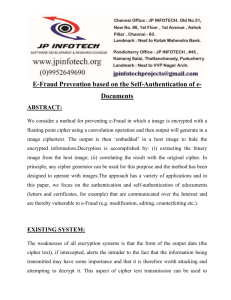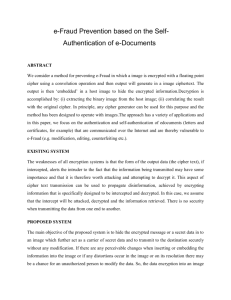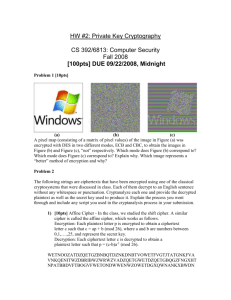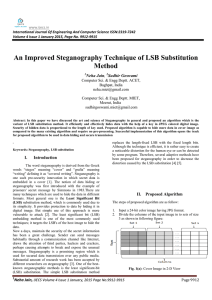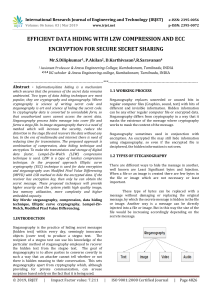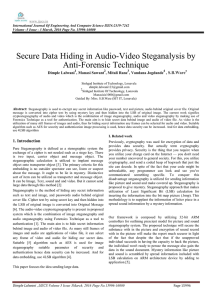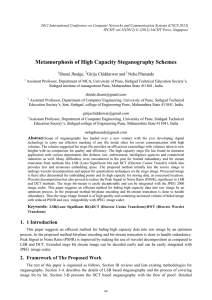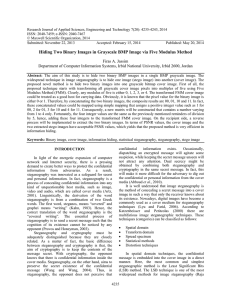PROVIDE SECURE AUTHENTICITY FOR PROPAGATING INFORMATION
advertisement
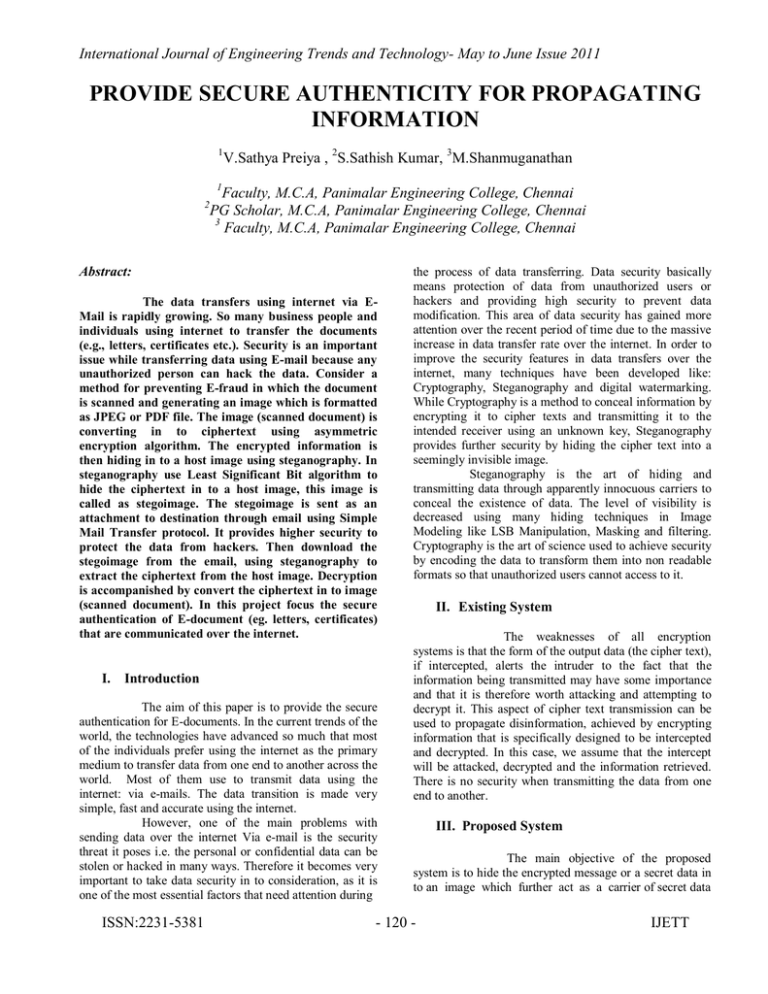
International Journal of Engineering Trends and Technology- May to June Issue 2011 PROVIDE SECURE AUTHENTICITY FOR PROPAGATING INFORMATION 1 V.Sathya Preiya , 2S.Sathish Kumar, 3M.Shanmuganathan 1 2 Faculty, M.C.A, Panimalar Engineering College, Chennai PG Scholar, M.C.A, Panimalar Engineering College, Chennai 3 Faculty, M.C.A, Panimalar Engineering College, Chennai Abstract: The data transfers using internet via EMail is rapidly growing. So many business people and individuals using internet to transfer the documents (e.g., letters, certificates etc.). Security is an important issue while transferring data using E-mail because any unauthorized person can hack the data. Consider a method for preventing E-fraud in which the document is scanned and generating an image which is formatted as JPEG or PDF file. The image (scanned document) is converting in to ciphertext using asymmetric encryption algorithm. The encrypted information is then hiding in to a host image using steganography. In steganography use Least Significant Bit algorithm to hide the ciphertext in to a host image, this image is called as stegoimage. The stegoimage is sent as an attachment to destination through email using Simple Mail Transfer protocol. It provides higher security to protect the data from hackers. Then download the stegoimage from the email, using steganography to extract the ciphertext from the host image. Decryption is accompanished by convert the ciphertext in to image (scanned document). In this project focus the secure authentication of E-document (eg. letters, certificates) that are communicated over the internet. I. Introduction The aim of this paper is to provide the secure authentication for E-documents. In the current trends of the world, the technologies have advanced so much that most of the individuals prefer using the internet as the primary medium to transfer data from one end to another across the world. Most of them use to transmit data using the internet: via e-mails. The data transition is made very simple, fast and accurate using the internet. However, one of the main problems with sending data over the internet Via e-mail is the security threat it poses i.e. the personal or confidential data can be stolen or hacked in many ways. Therefore it becomes very important to take data security in to consideration, as it is one of the most essential factors that need attention during ISSN:2231-5381 the process of data transferring. Data security basically means protection of data from unauthorized users or hackers and providing high security to prevent data modification. This area of data security has gained more attention over the recent period of time due to the massive increase in data transfer rate over the internet. In order to improve the security features in data transfers over the internet, many techniques have been developed like: Cryptography, Steganography and digital watermarking. While Cryptography is a method to conceal information by encrypting it to cipher texts and transmitting it to the intended receiver using an unknown key, Steganography provides further security by hiding the cipher text into a seemingly invisible image. Steganography is the art of hiding and transmitting data through apparently innocuous carriers to conceal the existence of data. The level of visibility is decreased using many hiding techniques in Image Modeling like LSB Manipulation, Masking and filtering. Cryptography is the art of science used to achieve security by encoding the data to transform them into non readable formats so that unauthorized users cannot access to it. II. Existing System The weaknesses of all encryption systems is that the form of the output data (the cipher text), if intercepted, alerts the intruder to the fact that the information being transmitted may have some importance and that it is therefore worth attacking and attempting to decrypt it. This aspect of cipher text transmission can be used to propagate disinformation, achieved by encrypting information that is specifically designed to be intercepted and decrypted. In this case, we assume that the intercept will be attacked, decrypted and the information retrieved. There is no security when transmitting the data from one end to another. III. Proposed System The main objective of the proposed system is to hide the encrypted message or a secret data in to an image which further act as a carrier of secret data - 120 - IJETT International Journal of Engineering Trends and Technology- May to June Issue 2011 and to transmit to the destination securely without any modification. If there are any perceivable changes when inserting or embedding the information into the image or if any distortions occur in the image or on its resolution there may be a chance for an unauthorized person to modify the data. So, the data encryption into an image and decryption and steganography is used to protect the data from unauthorized person, this plays a major role in the project. The scheme allows for the authentication and selfauthentication of documents such as letters, certificates and other image based data. The encrypted watermark can be camouflaged to obfuscate its existence and the applications to which the method can be applied are numerous. For example, the self-authentication of edocuments sent as attachments over the internet provides a unique facility for many legal and financial transactions that have traditionally relied on paper based documents to secure authenticity. IV. Module Description 1. Image Conversion 2. Encryption 3. Hiding Text Hiding Text Steganography is the process of hiding the one information in to other sources of information like text, image or audio file so that it is not visible to the natural view. Here, the image is encrypted, then encrypted information hidden in a host image using least significant bit algorithm. LSB is a process adjusting least significant bit pixels of the carrier image. It is a simple approach to embedding a message in to the image. The Least Significant Bit insertion varies according to number of bits in an image. The encrypted text is hiding in to an 8 bit image (BMP Image); the least significant bit i.e., the 8thbit of each byte of the image is changed to the bit of secret message. LSB is effective in using BMP images since the compression in BMP is lossless. But for hiding the encrypted information inside an image of BMP file using LSB algorithm it requires a large image which is used as a cover. The encrypted information is hidden in a cover image is called as stegoimage. The stego key is used to extract the hidden data from a stegoimage.The stego key is a secret key used to protect the hidden message in an image. The stegoimage should be sent as an attachment to destination through the mail using SMTP protocol. 4. Text Extraction 5. Decryption Text Extraction Image Conversion To convert the image into binary image by using Quantization Technique. The color Quantization is a process that reduces the number of distinct colors in an image. It is a lossy compression technique achieved by compressing a range of values. When convert an image in to 1-bit per pixel they have a chance to losing image quality. By using this technique quality of the image is maintained. When converting an image in to one bit per pixel, in signal processing the frequency values may be vary. If the value is decimal then quality of an image is loss, by using quantization round off the decimal value for a quality image. Encryption The binary image should be converted in to block of bytes using serialization. The encrypting data (block of bytes) using an asymmetric encryption algorithm. Interpret each pair of bytes as a decimal integer value. Use the encryption function to encrypt the numeric plaintext values using the public key. The encrypted function gives an integer value, and then converts the integer value in to hexadecimal value. Concatenate the hexadecimal value to form a cipher text. ISSN:2231-5381 The stegoimage is downloading from the Email, read the watermarked image from a file. The hidden text is extracted from the host image using a stego key. The stego key is used to extract the lowest 1-bit layer from the image. The stego key finds the 8-bit binary number of each pixel RGB color. The LSB of each pixel's 8-bit binary number is one bit of the hidden data file. Extract the one bit from an image; finally get the secret data and the hidden message stored in a file. Decryption The encrypted information extract from an image and using a private key to decrypt the hidden message. Break the ciphertext into small blocks of data that are the same length as the public key modulus. The blocks of data containing a hexadecimal string. The interpret each hexadecimal string as a decimal integer value. Use the decryption function to decrypt the integer values using the private key. Represent each decrypted value as a pair of bytes. By using decryption the ciphertext convert in to block of bytes .After decryption the bytes converted in to binary image using deserialization.The block of bytes are convert in to 1-bit per pixel by using deserialization.The binary image is converted in to image by using dequantization. - 121 - IJETT International Journal of Engineering Trends and Technology- May to June Issue 2011 encrypted information is embedded and is protected with a password which is highly secured. By using this application the image (scanned document) is securely sent to the destination through E-mail. The proposed approach provides higher security and can protect the message from stego attacks. By using the Least Significant Bit algorithm in this project for developing the application which is faster and reliable and compression ratio is moderate compared to other algorithms.The major limitation of the application is designed for bit map images (.bmp). It accepts only bit map images as a carrier file, and the compression depends on the document size as well as the carrier image size. Architectural Design Sender VI. Future Enhancement The future work on this project is to improve the compression ratio of the image. In future different types of images are used to hide the encrypted information. The types of image fomats like .jpeg, .gif, .jpg, .tif etc. The security using Least Significant Bit Algorithm is good but we can improve security level in future to use F5 Algorithm and JSTEG algorithm. As well as using different algorithm for encryption and decryption. VII. Reciever References [1] S.Katzenbeisser and F.Petitcolas, “Information Hiding Techniques for Steganograph and Digital Watermarking”, Artech House, 2000. [2] N. F. Johnson, Z. Duric and S. Jajodia, “Information Hiding: The Steganography and Watermarking - Attacks and Countermeasures”,Kluwer Academicf Publishers, 2001. [3] P. R. Marie, “Fractal-Based Models for Internet Traffic and Their Application to Secure Data Transmission”, PhD Thesis, Loughborough University, 2007. [4] W. R. Harwood, “The Disinformation Cycle: Hoaxes, Delusions, Security Beliefs, and Compulsory Mediocrity” , XlibrisCorporation, 2002. V. Conclusion Security is an important issue while transferring the data using internet via E-mail because any unauthorized person can hack the data. The proposed approach provides higher security to protect the data. The proposed approach in this project uses a new steganographic approach called image steganography, cryptography and quantization technique. The cryptography provides secure solution to convert the image in to unreadable format. The Quantization provides the quality image when converting image in to binary image. The application creates a stego image in which the ISSN:2231-5381 [5] T. Newark and J. F. Borsarello, “Book of Camouflage Brassey’s”, 2002. [6] H. Gerrad and P.D.Antill, Crete 1941: “Germany’s Lightning Airborne Assault, Osprey Publishing” , 2005. [7] R. Canetti, C. Dwork, M. Naor and R. Ostrovsky. “Deniable Encryption, Theory of ryptography Library” , ePrint Archive, 1996. - 122 - IJETT


